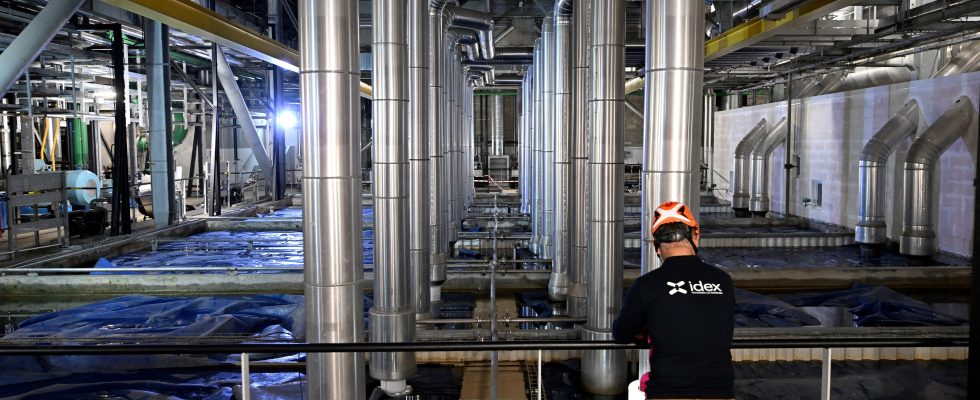These are still little-known networks that circulate discreetly in a few large French cities. In Paris, in the heart of the capital, pipes through which icy water passes make it possible to air-condition the Louvre Museum, the National Assembly, but also department stores, hotels and office buildings. A refrigeration network – the largest in Europe – in full expansion, operated by Fraîcheur de Paris (a consortium of Engie and RATP) and which should become the longest in the world within twenty years, aiming 252 kilometers of fresh pipes. In Lyon, it is a historic network in which water flows at 10°C, pumped since the 1970s at the level of a car park, and which supplies a shopping centre, a hospital and hotels in the La Part district. -God.
Networks in full development at a time when the imperative to adapt cities to climate change is essential each summer with great blows of thermal records. “The Part-Dieu cooling network is 1 million square meters connected, to which are added 300,000 square meters of the new network in the Gerland district”, explains Philippe Guelpa-Bonaro, vice-president delegated to the climate of the metropolis of Lyon. A considerable asset for these cities which, according to its promoters, has a double advantage: reducing CO₂ emissions with an energy-efficient solution and avoiding the production of urban heat islands caused by the presence of multiple individual air conditioners.
Steady growth
“The implementation of individual air conditioning solutions reinforces urban heat islands, and this feeling of suffocating atmosphere contributes in turn to an increase in electricity consumption for cooling”, underlines Cindy Melfort, from the Center for studies and expertise on risks, the environment, mobility and planning (Cerema). According to figures from theFrench Environment and Energy Management Agency (Ademe)in the medium term, France could even suffocate under the effects of air conditioning: if the installed power intended for air conditioners doubled, the outside temperature during heat waves could rise by 3°C.
For thirty years in France, these networks have experienced steady growth and are currently in operation forty, for a good part in the southern half of France. Nice, Marseille, Toulouse or Bordeaux use them to cool offices, shops or nursing homes. To find an economic balance, cooling networks must be able to serve a sufficient number of customers to make investments profitable, which explains their concentration in large cities, unlike heating networks, which are also found in small towns. .
Seawater to cool buildings
There remains a sector that still escapes the exponential growth of cooling networks: housing. Only a few households located in districts of Lyon, Montpellier or Marseille are connected in this way. “Until now, cooling networks were intended for large consumers, such as hospitals or office buildings, because this made it easier to amortize the significant costs of infrastructure”, explains Cindy Melfort, from Cerema. But, with the evolution of demand and the growing expectation in terms of “summer comfort” in housing, the lines are moving. “The question occupies us, recognizes Philippe Guelpa-Bonaro, vice-president of the metropolis of Lyon. We thought until now that only public facilities and offices needed to be refreshed, since residential buildings were used in the evening. , when it is cool.” But, with an air conditioning penetration rate that has already reached 30% of homes in Greater Lyon, the elected official wants the issue of virtuous cooling networks for homes to be fully integrated into the revision of the climate plan for the agglomeration.
In recent districts, made up of offices and housing, new solutions are gradually being put in place, allowing the use of so-called “passive” networks, making maximum use of the thermal resources offered by the environment. In Marseille, 58,000 square meters located in the Euromed 2 district have been supplied since 2017 by a heating and cooling network that draws its water from the sea. The system, called “thalassothermy”, captures water at between 14 and 24°C depending on the season, to send it to a heat exchanger which is itself connected to a temperate freshwater loop, before returning it to the sea. The flow from the freshwater loop then supplies heat pumps responsible for producing domestic hot water, heating or air conditioning in summer.
French know-how at the top of European countries
Much more energy efficient than individual air conditioners, these solutions are not completely free of electricity consumption. In the capital, the network developed and operated by the Fraîcheur de Paris group has been supplied by 100% renewable electricity since 2013, but not all operators can say the same. “Today it is difficult to determine the rates of renewable energies used in cooling networks, but this will become a challenge to obtain subsidies, and thus accelerate the development of these installations”, judges Cindy Melfort, from Cerema.
As such, France has a card to play. Because, on the scale of Europe (which has more than a hundred cooling networks), France is by far No. 1 in terms of installed power, according to the observatory of heating and cooling networks from Cerema. “France is well positioned, with historical networks and a well-established sector, and companies that have real know-how”, underlines Cindy Melfort. An asset on which the government should now rely during the debates on the multiannual energy programming. “We have talked a lot about heating networks, which have boomed with the energy crisis, but we feel that there is now a real listening on the subject of cold, which is why we recommend using the same strategy to develop these solutions”, assures Pierre de Montlivault, president of the Federation of environmental energy services (Fedene), which brings together players in the sector.
